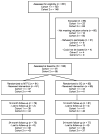Effects of multidimensional treatment foster care on psychotic symptoms in girls
- PMID: 25457926
- PMCID: PMC4254696
- DOI: 10.1016/j.jaac.2014.08.014
Effects of multidimensional treatment foster care on psychotic symptoms in girls
Abstract
Objective: Neurodevelopmental theories of psychosis highlight the potential benefits of early intervention, prevention, and/or preemption. How early intervention should take place has not been established, nor whether interventions based on social learning principles can have preemptive effects. The objective was to test whether a comprehensive psychosocial intervention can significantly alter psychotic symptom trajectories during adolescence-a period of heightened risk for a wide range of psychopathology.
Method: This study was a randomized controlled trial (RCT) of Multidimensional Treatment Foster Care (MTFC) for delinquent adolescent girls. Assessment of psychotic symptoms took place at baseline and then 6, 12, 18, and 24 months post-baseline using a standardized self-report instrument (Brief Symptom Inventory). A second source of information about psychotic symptoms was obtained at baseline or 12 months, and again at 24 months using a structured diagnostic interview (the Diagnostic Interview Schedule for Children [DISC]).
Results: Significant benefits for MTFC over treatment as usual for psychosis symptoms were observed over a 24-month period. Findings were replicated across both measures. Effects were independent of substance use and initial symptom severity and persisted beyond the initial intervention period.
Conclusion: Ameliorating nonclinical psychotic symptoms trajectories beginning in mid-adolescence via a multifaceted psychosocial intervention is possible. Developmental research on nonclinical psychotic symptoms and their prognostic value should be complemented by more psychosocial intervention research aimed at modifying these symptom trajectories early in their natural history. Clinical trial registration information-Juvenile Justice Girls Randomized Control Trial: Young Adult Follow-up; http://clinicaltrials.gov; NCT01341626.
Keywords: MTFC; RCT; girls; juvenile justice; psychotic symptoms.
Copyright © 2014 American Academy of Child and Adolescent Psychiatry. Published by Elsevier Inc. All rights reserved.
Figures


Comment in
-
Multidimensional Treatment Foster Care and Psychotic Symptoms.J Am Acad Child Adolesc Psychiatry. 2017 Jan;56(1):89. doi: 10.1016/j.jaac.2016.10.008. J Am Acad Child Adolesc Psychiatry. 2017. PMID: 27993234 No abstract available.
-
Dr. Leve et al. reply.J Am Acad Child Adolesc Psychiatry. 2017 Jan;56(1):90. doi: 10.1016/j.jaac.2016.10.013. J Am Acad Child Adolesc Psychiatry. 2017. PMID: 27993235 No abstract available.
References
-
- Poulton R, Caspi A, Moffitt TE, Cannon M, Murray RM, Harrington HL. Children’s self-reported psychotic symptoms and adult schizophreniform disorder: A 15-year longitudinal study. Arch Gen Psychiatry. 2000;57:1053–1058. - PubMed
-
- Welham J, Scott J, Williams G, et al. Emotional and behavioural antecedents of young adults who screen positive for non-affective psychosis: a 21-year birth cohort study. Psychol Med. 2009;39:625–634. - PubMed
-
- Kaymaz N, Drukker M, Lieb R, et al. Do subthreshold psychotic experiences predict clinical outcomes in unselected non-help-seeking population-based samples? A systematic review and meta-analysis, enriched with new results. Psychol Med. 2012;42:2239–2253. - PubMed
-
- Cannon M, Caspi A, Moffitt TE, et al. Evidence for early-childhood, pan-developmental impairment specific to schizophreniform disorder - Results from a longitudinal birth cohort. Arch Gen Psychiatry. 2002;59:449–456. - PubMed
-
- Kelleher I, Cannon M. Psychotic-like experiences in the general population: characterizing a high-risk group for psychosis. Psychol Med. 2011;41:1–6. - PubMed
Publication types
MeSH terms
Associated data
Grants and funding
LinkOut - more resources
Full Text Sources
Other Literature Sources
Medical

